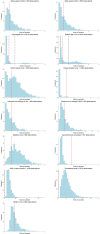Genetic Analyses of Common Infections in the Avon Longitudinal Study of Parents and Children Cohort
- PMID: 34804013
- PMCID: PMC8599591
- DOI: 10.3389/fimmu.2021.727457
Genetic Analyses of Common Infections in the Avon Longitudinal Study of Parents and Children Cohort
Abstract
The burden of infections on an individual and public health is profound. Many observational studies have shown a link between infections and the pathogenesis of disease; however a greater understanding of the role of host genetics is essential. Children from the longitudinal birth cohort, the Avon Longitudinal Study of Parents and Children, had 14 antibodies measured in plasma at age 7: Alpha-casein protein, beta-casein protein, cytomegalovirus, Epstein-Barr virus, feline herpes virus, Helicobacter pylori, herpes simplex virus 1, influenza virus subtype H1N1, influenza virus subtype H3N2, measles virus, Saccharomyces cerevisiae, Theiler's virus, Toxoplasma gondii, and SAG1 protein domain, a surface antigen of Toxoplasma gondii measured for greater precision. We performed genome-wide association analyses of antibody levels against these 14 infections (N = 357 - 5010) and identified three genome-wide signals (P < 5×10-8), two associated with measles virus antibodies and one with Toxoplasma gondii antibodies. In an association analysis focused on the human leukocyte antigen (HLA) region of the genome, we further detected 15 HLA alleles at a two-digit resolution and 23 HLA alleles at a four-digit resolution associated with five antibodies, with eight HLA alleles associated with Epstein-Barr virus antibodies showing strong evidence of replication in UK Biobank. We discuss how our findings from antibody levels complement other studies using self-reported phenotypes in understanding the architecture of host genetics related to infections.
Keywords: ALSPAC; HLA; antibody; genetics; infection.
Copyright © 2021 Chong, Mitchell, Hemani, Davey Smith, Yolken, Richmond and Paternoster.
Conflict of interest statement
The authors declare that the research was conducted in the absence of any commercial or financial relationships that could be construed as a potential conflict of interest.
Figures


Similar articles
-
Longitudinal serological measures of common infection in the Avon Longitudinal Study of Parents and Children cohort.Wellcome Open Res. 2018 Jul 23;3:49. doi: 10.12688/wellcomeopenres.14565.2. eCollection 2018. Wellcome Open Res. 2018. PMID: 30467552 Free PMC article.
-
Infectious serologies and autoantibodies in inflammatory bowel disease: insinuations at a true pathogenic role.Ann N Y Acad Sci. 2009 Sep;1173:640-8. doi: 10.1111/j.1749-6632.2009.04673.x. Ann N Y Acad Sci. 2009. PMID: 19758210
-
Infectious serologies and autoantibodies in Wegener's granulomatosis and other vasculitides: novel associations disclosed using the Rad BioPlex 2200.Ann N Y Acad Sci. 2009 Sep;1173:649-57. doi: 10.1111/j.1749-6632.2009.04641.x. Ann N Y Acad Sci. 2009. PMID: 19758211
-
[Development of immunological antigen for detecting Toxoplasma gondii infection].Zhongguo Xue Xi Chong Bing Fang Zhi Za Zhi. 2011 Oct;23(5):590-4. Zhongguo Xue Xi Chong Bing Fang Zhi Za Zhi. 2011. PMID: 22263520 Review. Chinese.
-
Serological recognition of Toxoplasma gondii cyst antigens.Curr Top Microbiol Immunol. 1996;219:67-73. doi: 10.1007/978-3-642-51014-4_7. Curr Top Microbiol Immunol. 1996. PMID: 8791690 Review. No abstract available.
Cited by
-
Causal associations between Helicobacter pylori infection and pregnancy and neonatal outcomes: a two-sample Mendelian randomization study.Front Cell Infect Microbiol. 2024 Mar 14;14:1343499. doi: 10.3389/fcimb.2024.1343499. eCollection 2024. Front Cell Infect Microbiol. 2024. PMID: 38558850 Free PMC article.
-
Global trends and risk factors in gastric cancer: a comprehensive analysis of the Global Burden of Disease Study 2021 and multi-omics data.Int J Med Sci. 2025 Jan 1;22(2):341-356. doi: 10.7150/ijms.104437. eCollection 2025. Int J Med Sci. 2025. PMID: 39781526 Free PMC article.
-
A Developmentally-Informative Genome-wide Association Study of Alcohol Use Frequency.Behav Genet. 2024 Mar;54(2):151-168. doi: 10.1007/s10519-023-10170-x. Epub 2023 Dec 18. Behav Genet. 2024. PMID: 38108996 Free PMC article.
-
The causal effect of Helicobacter pylori infection on coronary heart disease is mediated by the body mass index: a Mendelian randomization study.Sci Rep. 2024 Jan 19;14(1):1688. doi: 10.1038/s41598-024-51701-8. Sci Rep. 2024. PMID: 38243041 Free PMC article.
-
Proteome-wide Mendelian randomization identifies potential therapeutic targets for nonalcoholic fatty liver diseases.Sci Rep. 2024 May 23;14(1):11814. doi: 10.1038/s41598-024-62742-4. Sci Rep. 2024. PMID: 38782984 Free PMC article.
References
Publication types
MeSH terms
Substances
Grants and funding
- MC_UU_00011/7/MRC_/Medical Research Council/United Kingdom
- MC_QA137853/MRC_/Medical Research Council/United Kingdom
- MC_UU_00011/1/MRC_/Medical Research Council/United Kingdom
- MC_UU_00011/4/MRC_/Medical Research Council/United Kingdom
- 208806/Z/17/Z/WT_/Wellcome Trust/United Kingdom
- MC_PC_17228/MRC_/Medical Research Council/United Kingdom
- MC_UU_00011/3/MRC_/Medical Research Council/United Kingdom
- MC_UU_00011/5/MRC_/Medical Research Council/United Kingdom
- G9815508/MRC_/Medical Research Council/United Kingdom
- 217065/Z/19/Z/WT_/Wellcome Trust/United Kingdom
- MC_PC_19009/MRC_/Medical Research Council/United Kingdom
- 076467/Z/05/Z/WT_/Wellcome Trust/United Kingdom
- MC_PC_15018/MRC_/Medical Research Council/United Kingdom
LinkOut - more resources
Full Text Sources
Medical
Molecular Biology Databases
Research Materials

